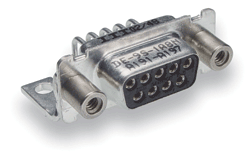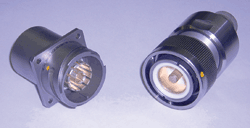It’s all about amperage
Specifying connectors for high-power applications
BY TED WORROLL and MIKE GARDINER
ITT Interconnect Solutions
Santa Ana, CA
http://www.ittcannon.com
When selecting connectors for high-power applications, many specifications are important but none more so than amperage. In a variety of high-power applications such as power supplies, telecom, military, transportation, and lighting systems, customers often require a very specific amperage.
Connector manufacturers must be able to match this specification in their connector design to meet application-specific needs. However, as with many components, meeting high-power requirements requires a variety of hurdles to be overcome.
The size of power
One of the most significant challenges comes in meeting high-amperage requirements while maintaining a low connector profile. Manufacturers of hybrid vehicles, for example, are looking for a quick charge into the vehicle while requiring higher amperage in a smaller device.
Despite the connector being implemented into a larger application, the device size needs to be minimized because in hybrid vehicles, reduced weight of the overall car is key to improving fuel efficiency. Since the car has multiple areas to connect, hybrid-vehicle manufacturers are often requiring connectors to do more in a condensed package.
As amperage increases so does the connector size, making it increasingly difficult to meet both current and real-estate constraints. Some power connector designs implement Euro-style brackets to minimize the space required by the connector.

Some power connectors use Eurostyle brackets to conserve space.
The right contacts
Not only is the trend shifting to higher amperage requirements but customers also look for high amperage over several poles, despite the fact that increased amperage is typically consistent with a single-position connector. Still, engineers often prefer the design flexibility and freedom to control several high-current circuits in one connector.
There are several options to meet this challenge in customer design requirements. When driving high power through several contacts within a single shell, selecting a high-conductivity material that will generate little heat is imperative particularly because the closer the contacts are placed to each other, the more difficult it is to dissipate heat. Materials such as copper alloy 101 or tellurium are the first choices, although tellurium is much more costly.
Using such high-conductivity materials also allows contacts to be placed much closer together than if using brass or beryllium copper. While heat will always be a factor as long as power increases, the size of the contacts, base materials, and finish will work together to handle and dissipate heat as necessary.
While it is much more cost-effective to employ a typical brass material than a more expensive material such as a copper alloy, brass does not exhibit properties that—when used in a smaller footprint—allow a higher current to pass through, effectively disperse heat, and, as a result, eliminate degradation in terms of fall-off, as copper alloy does. Connector manufacturers continue to investigate the use of existing alloys that are able to carry a higher current in a smaller form factor while meeting cost constraints.
A material world
Additionally, the higher the power rating, the more the connector pin will be derated. All components, including connectors, have limits.

Connectors with high power ratings, like this 1,000-A part, are often used in applications such as military field equipment, sea borne vehicles, and industrial applications.
The diameter, plating, and homogeneity of the connector material determines how well it will be able to withstand the maximum rated load and therefore contribute to the derating calculation of the connector. For example, throughout the testing process, as voltages are applied and currents are induced, there will come a point where the materials that comprise the pin terminal will not be able to withstand the power and thus fail testing.
To achieve maximum power in the connector design, the insulator material should be of a high dielectric strength and high-conductivity contact material should be employed, as noted above. Other considerations include designing the interface to eliminate free-standing contacts with no encasement.
As a result, the creepage and air gap distance will be very short, causing electrical issues. This is solved by isolating the contacts with a plastic wall between them, thereby increasing the air gap and creepage distances.
Keeping the user safe
While amperage is far and away the key element when specifying connectors for high-power applications, other design considerations still come into play, such as environmental factors. Specifically, the environment plays a role in terms of safety precautions and sealing specifications.

A sealed connector can provide additional safety features to eliminate user risk.
For example, exposure to moisture or even human touch can cause connector failure, making sealing to IP 67 standards paramount. Some connectors can be or are equipped with Teflon fingertip protection at the connector interface, eliminating the risk of electrocution if the connector is unmated.
High-rated contacts often employ such safety features so as to increase reliability, reduce risk, and meet all specified safety requirements. Other applications, such as mass transportation, call for connectors to comply with DIN-rail specifications. ■
For more on connectors, visit http://www2.electronicproducts.com/Interconnections.aspx.
Advertisement
Learn more about ITT Electronic Components





